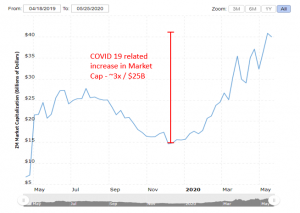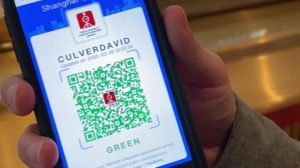Zoom Is Ethically Required to Improve Privacy And Regulation Is Needed
By Matthew McElhaney | May 29, 2020
Zoom is a ubiquitous video conferencing software whose popularity increased dramatically during the stay at home orders during the 2020 pandemic. Zoom built its platform on ease of use and ?frictionless communication? (Barolo, 2018), and it appears the architecture and design decisions to allow individuals to easily video conference has led to extreme privacy concerns. The internet has been filled with accounts of ?zoom bombing?-where uninvited individuals join video conferences and screen share pornography or shout racist epithets (O’Flaherty, 2020). The impact of this deplorable behavior is amplified given the increased use of zoom by grade schools across the United States during the stay at home orders related to COVID 19.

*Zoom Is Being Used for Social Distancing Court Hearings (Holmes, 2020)*
Company Value Has Skyrocketed Despite Privacy Concerns
To say the stay at home orders have been a boon to Zoom is an understatement. Zoom is publicly traded which allows us to apply near real time mark to market valuations to the company.

*Zoom Market Capitalization May 2019 to May 2020 (source: macrotrends.net)*
To give some perspective on the enterprise value of Zoom, the value of its equity at the time of writing is greater than that of Delta, American, and Southwest Airlines combined. It is also 2x that of Ford Motor Company-an iconic American institution that produces 5.5 million vehicles per year.

*Ford Market Capitalization May 2019 to May 2020. COVID 19 has moved value from many companies into a select few winners. (source: macrotrends.net)*
It?s unclear if the temporary drops in Zoom market cap in March and April could be attributed to the privacy concerns but it?s apparent that the market doesn?t link the value of the company to those concerns given the current all-time high company value. This is a signal that Zoom will not address these concerns because the market demands it, and that a different incentive is needed.
Zoom Has The Resources Needed To Change
Based on the above data Zoom certainly has the required resources to change. It would be feasible for Zoom to sell $100M of treasury stock (a mere 0.2% of its market capitalization) to apply the proceeds to improve privacy for their users. Assuming an all-in cost per employee of $300k per year, this issuance would give Zoom the resources to hire over 300 security architects, software developers, and other positions to address this issue.
Regulation Is Needed To Incentivize Change
Given that Zoom has been slow to apply the required changes even though it has the resources, and that their company valuation has increased during these privacy concerns, it?s clear that regulation should be considered in these situations to incentivize companies like Zoom to provide products with the necessary privacy controls. The United States government has been hesitant to do so in the past, likely because there is a fear of stifling innovation. The concerns are not valid given the harm done to consumers of the product because of poor privacy controls at the benefit of innovation. If laws were passed to apply extremely punitive penalties (e.g. the exact opposite of Facebook?s fine by the EU fine for being misleading during Whatsapp acquisition) to companies like Zoom for privacy and security violations, there would be far fewer children being exposed to pornography during English class. Companies respond to incentives and unless there is regulation to correct this behavior similar incidents will certainly happen again in the technology space.
References
Barolo, P. (2018, January 31). Zoom Launches Enhanced Product Suite to Deliver Frictionless Communications. Retrieved May 24, 2020, from https://blog.zoom.us/wordpress/2018/01/30/zoom-launches-enhanced-product-suite-to-deliver-frictionless-communications/
Holmes, A. (2020, April 18). Courts and government meetings have fallen into chaos after moving hearings to Zoom and getting swarmed with nudity and offensive remarks. Retrieved May 24, 2020, from https://www.businessinsider.com/zoom-courts-governments-struggle-to-adapt-video-tools-hearings-public-2020-4
O’Flaherty, K. (2020, March 27). Beware Zoom Users: Here’s How People Can ‘Zoom-Bomb’ Your Chat. Retrieved May 24, 2020, from https://www.forbes.com/sites/kateoflahertyuk/2020/03/27/beware-zoom-users-heres-how-people-can-zoom-bomb-your-chat/
Zoom Video Communications Market Cap 2019-2020: ZM. (n.d.). Retrieved May 24, 2020, from https://www.macrotrends.net/stocks/charts/ZM/zoom-video-communications/market-cap


